A post-2000 cryptocurrency prodigy from Shanghai, now earning a seven-figure monthly income and an eight-figure annual income. Not only does she have a beautiful appearance and a correct worldview, but her skills are also exceptional, representing the new generation. She is also a long-time friend from the cryptocurrency space. Recently, we met and discussed her glorious history. She spent five years learning and practicing in the cryptocurrency space. She said making money is very simple; many people overthink it. You just need to master the simplest candlestick patterns and trade. Her win rate is an astonishing 85%, achieving victory every time.
Through my own experience, I have achieved a win rate of as high as 80%. I have compiled this information over the past few days and am now sharing it with those who are interested, so we can learn and master it together.
This shows the stages and time cycles of bull and bear markets in the cryptocurrency space over the years: Four stages - Bear Market, Pre-Bull Market, Bull Market, and Super Bull Market. The astonishing price increases in each period contain obvious opportunities!
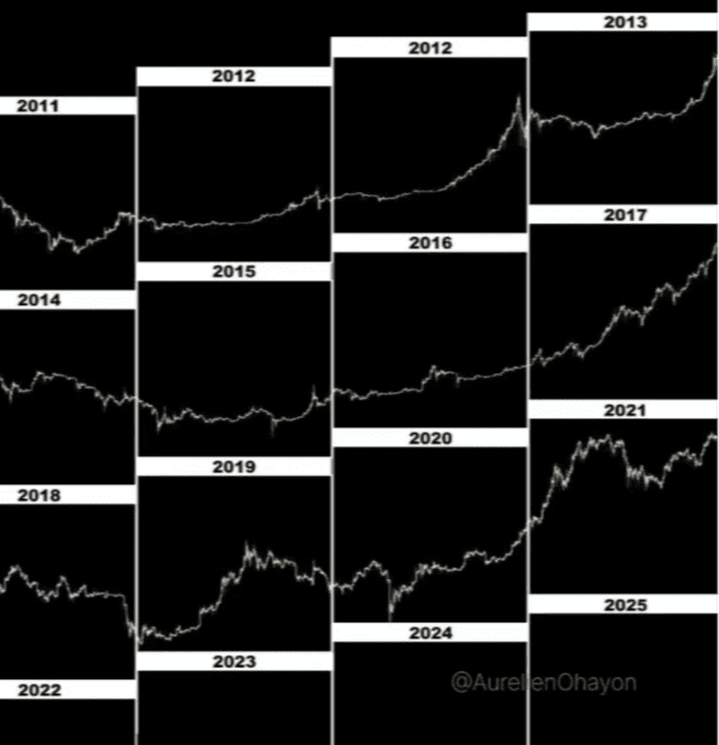
Bitcoin's cyclicality is very strong. A diagram illustrating this concept.

As shown in the above image, the three halving cycles in history (2012, 2016, and 2020) all led to enormous bull markets.
Now a monthly income in the seven figures and an annual income in the eight figures: By mastering candlesticks and recognizing patterns for trading, the win rate reaches an impressive 100%.

In the digital currency market, technical analysis is a very important indicator for predicting short-term market trends, commonly referred to as candlestick charts. Regardless of whether you believe in or advocate technical analysis, understanding candlestick charts is essential.
Not understanding candlesticks and trading recklessly is a major taboo in the cryptocurrency space! Excluding technical patterns, indicators, and the technical issues of the bulls and bears, fundamental information such as price trends, trading volume, lowest points, and highest points can all be reflected in candlestick charts.
What is a candlestick?
Candlestick charts are a fundamental part of entering all secondary markets. We also refer to candlestick charts as candle charts, which originated in Japan during the Tokugawa shogunate and were invented by Homma Munisai, initially used to record rice market trends, later introduced into stock and futures markets due to their unique graphic representation. Through candlestick charts, we can see the opening price, closing price, highest price, lowest price, and fluctuations within a certain period.
What benefit does analyzing candlestick charts provide me?
It can help you create better investment strategies and guide you to choose the best timing for buying and selling. For believers in accumulating cryptocurrencies, it is also necessary to understand this, as most trading interfaces on exchanges are dominated by candlestick charts, and not understanding them is quite embarrassing in the cryptocurrency space.
What information can be obtained from analyzing candlestick charts?
Through candlestick charts, you can see price trends over specific periods (30 minutes, 1 hour, 1 day, 1 week...), including the opening price, closing price, highest price, and lowest price. You can also observe the intense battles between bulls and bears.
Highlighting Key Points
Components of the Candlestick Chart
The main components of a candlestick chart are two: bullish candles and bearish candles.
Each candlestick represents four prices of the day: highest price, lowest price, opening price, and closing price. The part between the opening price and closing price is drawn as a 'rectangular body', and the highest and lowest prices are connected, forming the candlestick.
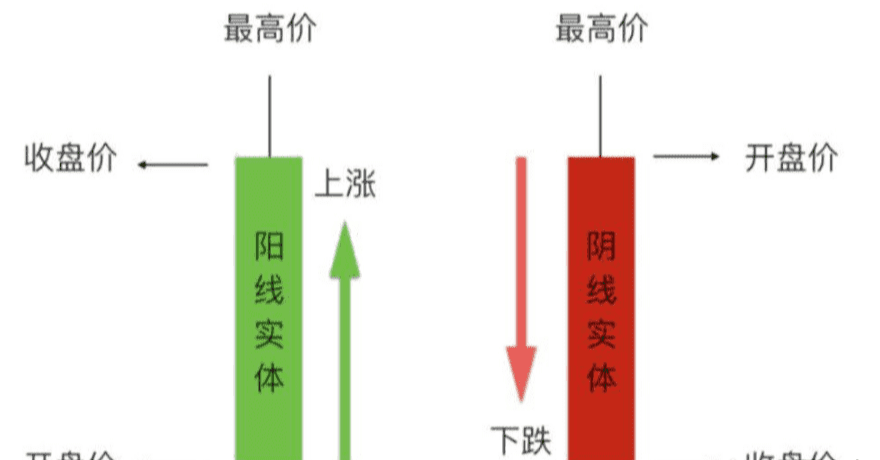
When the closing price is higher than the opening price, the body is green, indicating a price increase, which we call a bullish candle.
When the closing price is lower than the opening price, the body is red, indicating a price drop, which we call a bearish candle.
Most exchanges and analysis software in the cryptocurrency space use green to represent bullish candles and red to represent bearish candles. Generally, bullish candles represent the bulls (buying), and bearish candles represent the bears (selling). The stronger side will show the corresponding candlestick in the chart.
Taking daily candles as an example: if the buying power exceeds the selling power today, then today's candlestick on the daily chart will be a bullish candle (green bar). Conversely, if a bearish candle (red bar) appears, it indicates stronger selling power.
Note: In the Chinese stock market, bullish candles are red, and bearish candles are green; in some charts, bullish candles may appear as solid bars, while bearish candles appear as hollow bars.
What is a Shadow Line?
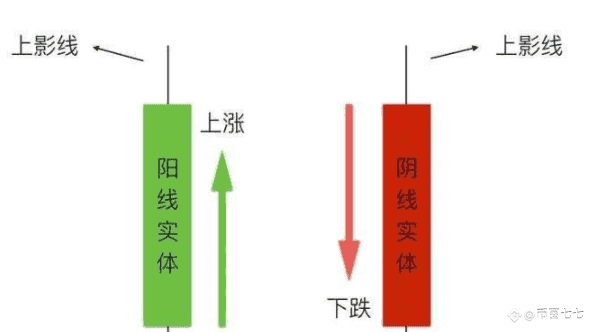
The shadow refers to the thin lines above and below the body, indicating the difference between the day's highest and lowest prices compared to the closing price. The longer the shadow, the greater the resistance. A longer upper shadow indicates stronger upward resistance, while a longer lower shadow indicates stronger downward resistance. Both upper and lower protruding lines from the body are referred to as upper shadows and lower shadows, respectively.
What is the battle between bulls and bears?
Bulls and bears are two factions; bulls represent the green faction, while bears represent the red faction. Their viewpoints differ, with bulls believing prices will rise and bears believing prices will fall, often resulting in battles. The bull faction is a group of people who are optimistic about prices and will buy to raise prices, while the bear faction consists of those who are pessimistic and will sell to push prices down.
In each time period, battles occur, if the bearish side wins, prices will drop, and the candlestick chart will show red; if the bullish side gains a significant advantage, it indicates strength, and the candlestick chart will show larger bodies. If the bearish side's resistance is weak, it indicates minimal resistance to the bullish side, and the candlestick chart will display short shadows.
Small Bullish Star, Small Bearish Star

A. Small Bullish Star:
Represents minimal price fluctuation throughout the day, with the opening price and closing price being extremely close, and the closing price slightly higher than the opening price.
The appearance of a Small Bullish Star indicates that the market is in a chaotic and unclear stage, making it impossible to predict the future price movements. At this time, one should comprehensively judge based on the shape of the previous candlestick combinations and the current price area.
B. Small Bearish Star:
The chart pattern of a Small Bearish Star is similar to that of a Small Bullish Star, except that the closing price is slightly lower than the opening price, indicating a weak market and an unclear future direction.
Small Bullish Candle, Small Bearish Candle

C. Small Bullish Candle:
Its fluctuation range is smaller, indicating that the bulls have a slight upper hand, but the upward momentum is weak, suggesting that market developments are unclear.
D. Small Bearish Candle:
Indicates that the bearish side is exerting pressure, but the force is not strong.
Naked Bullish Candle, Naked Bearish Candle

E. Naked Bullish Candle:
① If a Naked Bullish Candle appears in a low price area, it is reflected on the intraday chart as prices explore the bottom and then rise in waves with increasing volume, indicating the beginning of an upward trend. This shows that prices exhibit reduced volume during the bottom exploration process, and as prices gradually rise, the trading volume increases uniformly, ultimately closing with a bullish candle, suggesting a bullish outlook. If it appears during an upward trend, it indicates continued bullish sentiment.
② If an Inverted Hammer Bullish Candle appears in a high price area, it may indicate that the main force is raising the price to sell off, requiring caution.
F. Naked Bearish Candle:
If this type of line appears in a low price area, it indicates that the intervention of bargain hunters has led to signs of a price rebound, but the force is not strong.
Lower Shadow Bullish Candle, Lower Shadow Bearish Candle

G. Lower Shadow Bullish Candle:
Its appearance indicates that in the battle between bulls and bears, the bulls are attacking steadily and forcefully, with prices dipping first and then rising, indicating potential for further increases.
H. Lower Shadow Bearish Candle:
When it appears in a low price area, it indicates strong support below, suggesting the possibility of a price rebound.
Upper Shadow Bullish Candle, Upper Shadow Bearish Candle

I. Upper Shadow Bullish Candle:
① Indicates heavy selling pressure above during bullish attacks. This pattern is often seen during the main force's market testing actions, suggesting that there are many floating chips at this time, and the upward momentum is not strong.
② Indicates that the bullish side's attack has been hindered and is retreating, with heavy selling pressure above. Whether it can continue to rise is still uncertain.
J. Upper Shadow Bearish Candle:
When it appears in high price areas, it indicates severe selling pressure above, weak market conditions, and the possibility of a price reversal downward; if it appears in the middle price area during an upward trend, it suggests there is still room for further increases.
Naked Bullish Candle, Naked Bearish Candle

K. Naked Bullish Candle:
Indicates a strong upward momentum, but there is a divergence between bulls and bears at high price levels, cautious buying is advised.
L. Naked Bearish Candle:
The appearance of a Naked Bearish Candle indicates that although the price has rebounded, there is heavy selling pressure above.
Inverted Hammer Bullish Candle, Inverted Hammer Bearish Candle

M. Inverted Hammer Bullish Candle:
① The bulls have gained the upper hand, and a gradual upward trend appears, with prices steadily rising in conjunction with trading volume, indicating a bullish outlook.
Similarly, for the Inverted Hammer pattern, if the price movement shows a sideways trend or a decline for most of the time and suddenly spikes at the end, it may indicate a gap up followed by a drop.
③ If the price movement shows a wide range of fluctuations throughout the day and ends with a significant bullish candle, it may indicate that the main force is using fluctuations to drive away speculators, allowing for an easy price increase. The market may continue to show bullish sentiment.
N. Inverted Hammer Bearish Candle:
In contrast to the above Inverted Hammer Bullish Candle situation, it indicates a higher likelihood of a price drop.
Naked Bullish Candle, Naked Bearish Candle

O. Naked Bullish Candle:
Indicates that the bulls firmly control the market, gradually pushing prices higher with strong upward momentum.
P. Naked Bearish Candle:
Price stagnates, and a sudden volume increase at the end indicates that the bearish side ultimately gains dominant advantage, suggesting a higher possibility of a gap down.
If the price moves in a gradually declining trend, it indicates that the bears have gained the upper hand, and the bulls are unable to resist, leading to a gradual decrease in prices, with a bearish outlook ahead.
T-shaped Line, Inverted T-shaped Line

Q. T-shaped Line:
When it appears in a low price area, it indicates strong support below, suggesting the possibility of a price rebound.
R. Inverted T-shaped Line:
When it appears in a high price area, it indicates severe selling pressure above, weak market conditions, and the possibility of a price reversal downward.
If it appears in the middle price area during an upward trend, it suggests there is still room for further increases.
Doji Star
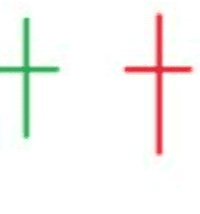
S. Doji Star:
This type of line is often referred to as a reversal Doji Star, which can appear in either high or low price areas, signaling potential changes in trend direction.
Summary of Candlestick Types
In addition to the above, we can also categorize candlestick types based on the body and shadows. They can mainly be divided into four categories.
①: K-line with no upper or lower shadows, only a body, is called a Naked Bullish Candle.
Indicates that one side has the upper hand in the buying and selling, dominating the market trades.
②: A small bearish or bullish body with no upper or lower shadows.
When the closing price is the highest or lowest price, the opening price is the lowest or highest price, and the fluctuations are limited, the battle between buyers and sellers is not intense. When the candlestick is bullish, buyers have a slight upper hand; when it is bearish, sellers have a slight upper hand. It generally occurs during price consolidation or during significant gaps in the market, and its significance is profound when large gaps occur, indicating that one side has achieved a comprehensive victory and the other side has collapsed completely.
③: A large bullish candle body with no upper or lower shadows.
Most often appears during an upward movement in the cryptocurrency market, where prices continue to rise, and although there are pullbacks, they quickly recover, with buyers resolutely pushing the price up.
④: A large bearish candle body with no upper or lower shadows.
Most often appears during a price decline, with the opposite meaning from above.
In the digital currency market, technical analysis is a very important indicator for predicting short-term market trends, commonly referred to as candlestick charts. Regardless of whether you believe in or advocate technical analysis, understanding candlestick charts is essential.
Not understanding candlesticks and trading recklessly is a major taboo in the cryptocurrency space! Excluding technical patterns, indicators, and the technical issues of the bulls and bears, fundamental information such as price trends, trading volume, lowest points, and highest points can all be reflected in candlestick charts.
Candlestick Patterns
Relying on candlestick patterns provides us with double assurance, giving us confidence.
Triggers our trades, thus learning candlestick patterns is equally important.
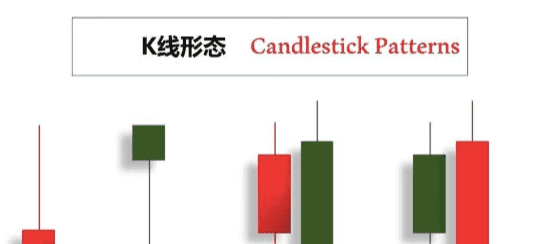
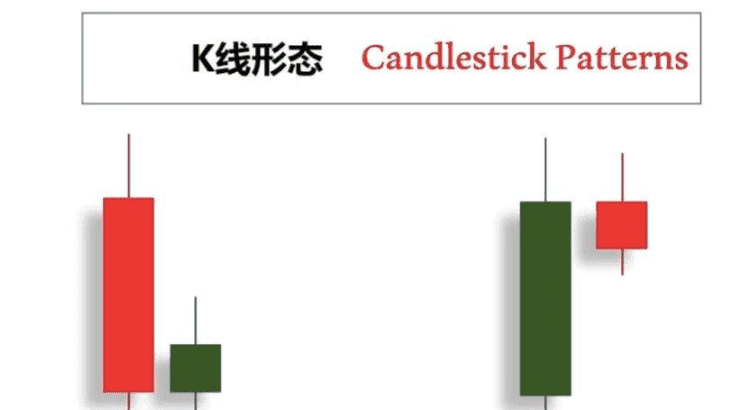
A bullish engulfing pattern consists of a bearish candle followed by a very small bullish candle, which is either the body or shadow of the previous candle.
The bearish engulfing pattern is the opposite, where the body and shadow of the bearish candle are both within the previous bullish candle.
Generally, there are two common methods to trade using this pattern.
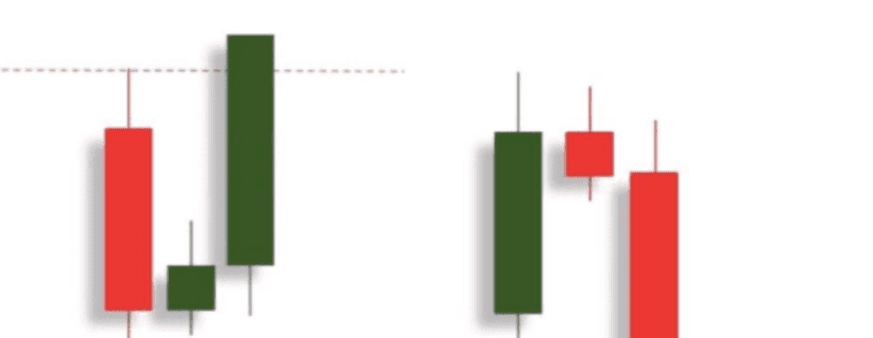
The first is that when the price breaks through the high or low of the previous candlestick, regardless of whether the latest candlestick has ended or not, we will enter the market to buy or sell, which is referred to as left-side trading.

The second, more conservative approach is to wait for the current candlestick to truly end at the high or low of the previous candlestick, and only enter the market once the direction is established.

Part Three: Chart Patterns
You will find that the market continuously performs a certain action through repeating patterns, and chart patterns provide a trace, allowing us to track what the market is currently doing and the logic behind it.

Common chart patterns frequently observed on the trading floor.
Ascending Triangle
Descending Triangle

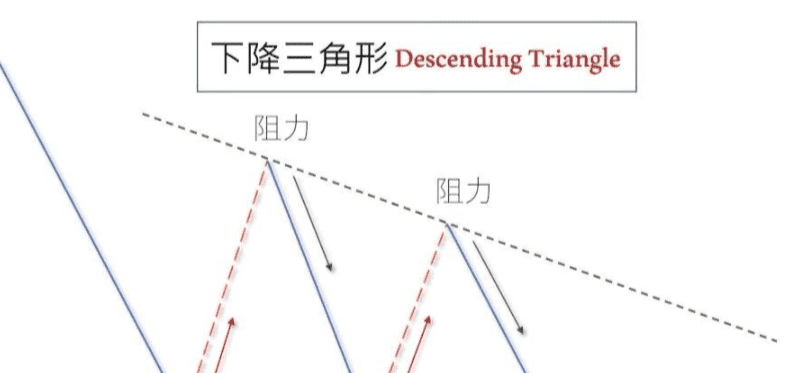
The descending triangle is the same; horizontal support levels affect prices. Each test is weaker than the last, ultimately leading to a successful breakout and continuing a downward trend.

In the long bear market, where is the end? In the current market conditions, many people can no longer hold on, facing two choices: either stop advancing and exit the cryptocurrency space, or endure and wait for the next bull market to begin.
However, only a small portion of people can survive in a bear market. Bull markets are like a windfall where even pigs can fly, while bear markets are a battlefield where only the fittest survive. So how can one survive in a bear market?

Lock in positions, stay away from the cryptocurrency market, and return when the next bull market begins. This rule requires a high level of self-discipline; very few can truly ignore everything. Those who can do it are not ordinary people.
Regular investment to reduce risk. Suitable for those who have invested small amounts initially and have stable personal income, with future returns not expected to be low.
Wait for the right opportunity to buy at the bottom. This risk is also significant; it's not easy for amateurs to avoid buying at mid-levels, turning short trades into long ones, and becoming shareholders.
Short-term trading, buying high and selling low. Risk level five stars, greater than the fourth type. Those who excel at this method will not get trapped in a bear market.
Cutting losses and staying away from the cryptocurrency market is advised. The drawback of this rule is that if you sell at the end of a bear market and immediately enter a big bull market, you will regret it for a lifetime. To avoid lifelong regret, this option is not recommended.
How should we invest and trade in a bear market?
One: Adhere to a long-term investment plan that aligns with financial goals.
For investors, whether in a bear or bull market, it is essential to adhere to long-term investment plans. During bear markets, there is often a lot of pessimistic information online, but it is best to ignore this market noise and focus on long-term returns. Some short-term traders quickly change their investment strategies to protect their funds or expand returns, but the reality is that if you find yourself in a bear market, it may already be too late to change asset allocations.
Two: Avoid timing the market for entry and exit.
Retail investors often make the mistake of trying to avoid the bear market by selling their positions. Exiting at high points and entering at low points seems simple, but it is not easy. Even if investors sell positions before a decline, they may not be able to catch the right timing to re-enter, as the market often turns sharply upwards when least expected. Historically, investors tend to exit during bear markets, preventing them from maximizing asset returns.
Three: Never attempt to guess tops and bottoms.
In a bear market, investors often want to sell all at once, but selling in batches may actually be a better choice. Do not try to evaluate the timing of entering and exiting; on average, the cost method (whether buying or selling) is generally more suitable.
Four: Accumulate cryptocurrencies
Regularly investing to accumulate cryptocurrencies. Most of the chips on the market are very cheap; accumulating cheap chips during a bear market means having stakes for profiting in the next bull market.
Five: Enhance theoretical learning, explore potential coins.
Learning is the key to continuous progress. This circle is ever-changing, with projects rising and falling, and technology constantly being updated. Not learning will only lead to being eliminated. In this bear market, it is essential to study hard and accumulate knowledge as capital for future battles.
This concludes today's sharing of trading experiences. Often, your doubts lead to missed opportunities for profit. If you don't dare to try, reach out, or understand, how will you know the pros and cons? You must take the first step to know what the next step should be. A warm cup of tea and a piece of advice, I am both a teacher and a good friend who talks freely.
Meeting is fate, knowing each other is destiny. Firmly believe that those destined will meet no matter how far apart, while those without fate will just pass by. The road of investment is long; momentary gains and losses are just the tip of the iceberg. It is essential to know that even the wisest will have misses, and even the foolish may have gains. Regardless of emotions, time will not stop for you. Set aside your worries and stand up to move forward.



